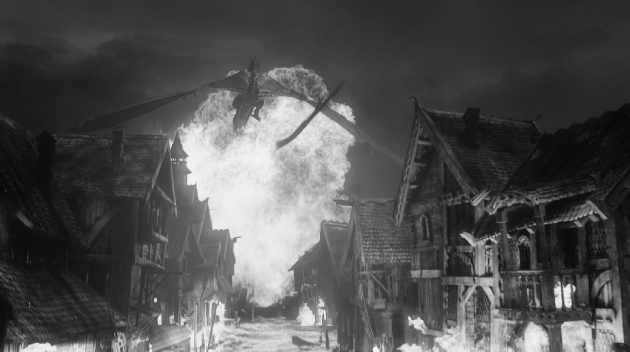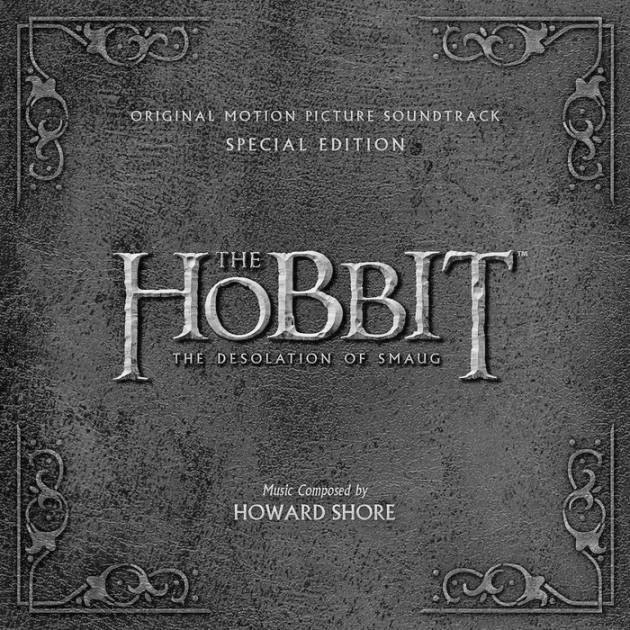Every single Peter Jackson Middle Earth film so far has has opened with an extensive prologue. When The Fellowship of the Ring entered theaters way back in 2001, an unfathomable amount of pressure rested on those precious opening minutes. If the audience could digest thousands of years of backstory and comprehend it, then the risky $300+ million adaptation just might work. If that opening prologue didn’t make sense, literally billions of dollars in potential revenue were at stake. Unsurprisingly the prologue concerning Sauron and the history of the ring was one of the very last sections of the film to be completed before the premiere. It worked and it’s success guaranteed a future for the two finished Middle Earth trilogies we have come this December.
It seems only natural that the sixth entry, The Hobbit: The Battle of the Five Armies, would uphold this hallowed tradition. Fellowship had the Battle of Dagorlad. The Two Towers featured Gandalf’s freefall battle with the Balrog. Return of the King showed us Smeagol’s transformation into Gollum. An Unexpected Journey showcased Smaug’s destruction of Dale and Erebor. And The Desolation of Smaug took us back to Gandalf’s initial meeting with Thorin in Bree.
The Witch-King Recruits Smaug
Back in the first Hobbit film, Radagast encounters the Witch-King of Angmar in Dol Guldur at some unspecified point in the past. In the second film, Radagast and Gandalf investigate the High Fells and discover that all nine Nazgul have mysteriously disappeared from their tombs. During the conversation between Bilbo and Smaug, new details come to light that cause us to question whether Bilbo is really the dragon’s first visitor since he took Erebor. Not only does Smaug seem perfectly knowledgeable about Thorin Oakenshield and his quest, but he also clearly knows something about the One Ring and Sauron’s army in Dol Guldur.
Smaug: “A darkness is coming. It will spread to every corner of the land.”Cut to Gandalf imprisoned in Dol Guldur.
Galadriel: The dragon has long been on your mind.
Gandalf: This is true, my lady. Smaug owes allegiance to no one, but if he should side with the enemy, a dragon could be used to terrible effect.
Gandalf Finds Thrain
Galadriel Rescues Gandalf
Goblins and Orcs
Sauron Resurrects Azog
The Rewind
No Prologue
- Why is Azog still alive when Bolg could have been perfectly serviceable? What is so special about the Defiler that he was needed to brought back to life to replace his son at the final battle?
- What is the deal with Dol Guldur? We’ve been teased it for two films but we still haven’t seen why it was so necessary to this particular adaptation of The Hobbit? And if Sauron wanted to keep it a secret, why did he breed giant easy-to-notice spiders there?
- What is the White Council up to? When are Galadriel, Elrond, and Saruman going to get involved in this whole spider infestation issue and the endless intrigue surrounding Dol Guldur?
- Where are the Ringwraiths? If we saw their empty tombs in the High Fells that means they are out doing something. What is the thing they are doing? Do they do anything besides conspicuously fumble their swords and leave them behind at the slightest provocation? Why does Sauron rely on the one-handed Azog instead of his chiefest lieutenants all of whom have two useable hands? Are the nine servants of evil not yet strong enough to take physical form like Sauron is? And do they ever get tired of being invincible unkillable ghosts whose only weakness is getting stabbed in the face by women?
- What is so special about Thrain that he needed to be teased in two movie trailers yet also cruelly withheld from us twice in a row for some sinister purpose that lies veiled in the shadows? Why was the White Council talking about Thrain’s ring of power in the extended edition and is that how Sauron is regaining his former strength? Does Sauron collect rings like how some people collect Magic cards?
- Speaking of rings of power, the elves were not corrupted by their rings like men and dwarves. Are we finally going to see Galadriel, Elrond, and Gandalf each wield their rings in a battle against Sauron? That would be the coolest thing ever.
- What is going on between Legolas and Tauriel? Did they used to date? Did they break up when Thranduil found out? Is there a good reason Legolas is still single in Lord of the Rings?
- Speaking of wood-elves, where is Thranduil’s moose? Can we please see him ride it into battle? Can somehow get some more details about the traditional use of war moose?
- Does Smaug have a good singing voice? I feel like he would. That baritone is just perfect for some kind of Hobbity song.
- What is Bilbo planning to do with the Arkenstone? He has it, right? Did anyone see him pick it up? He has to have it. There’s no way he doesn’t have it. I couldn’t quite see but he must have it, right?
- Is Legolas going to give Thorin his sword back? It’s so not cool for him to be killing orcs with the funnest sword that he lifted just so he could have it. Is anyone going to mention to Legolas that the handle of Orcrist is made from a dragon tooth and obviously belongs to Thorin for personal dragon reasons?
- Are the new characters like Tauriel, Alfrid, and Bard’s daughters who were invented for the movie, going to meet an untimely end? I feel like their chances are not good.
- Since Bilbo blacks out in the book during the final battle, will we not actually see the battle on screen and instead just hear people talking about the battle when Bilbo finally wakes up? Just thinking from a purist perspective, that would be logical, right?
- Are black arrows really that hard to make? They look kind of just like regular arrows but maybe bigger. There will be a perfectly good explanation for why people didn’t feel like making more after an actual dragon showed up, no?
- Also, why is Thorin such a jerk? I really liked him in the first movie. It seemed like he reconciled with Bilbo after the whole eagle rescue but now he’s back to trying to kill Bilbo. Is dragon sickness contagious? Should I be concerned here?
- Why did the Misty Mountain song disappear from the second movie? I know it was a bit overplayed in the first movie but can we have it back now? We’re sorry for complaining, Peter. One more time, for old times?
- Why are there no guardrails in Middle Earth? Don’t people ever fall off these walkways? Is there really no governmental agencies around to inspect bridges to make sure that children and drunks don’t accidentally plummet to their death? I know this is a faux history of a fantastical medieval European civilization and things were often brutally grimdark, but surely they still had guardrails. Are these magic guardrails that we can’t see because of a spell of concealment? I just find it hard to believe that elven architectural aesthetics trumps safety every time. We’re talking about saving lives here.


